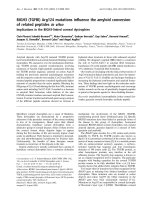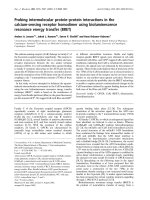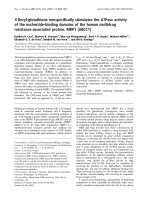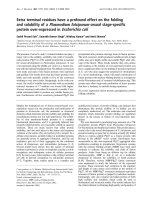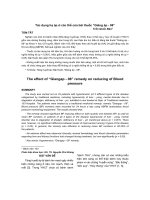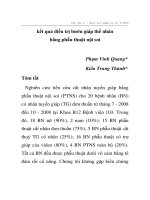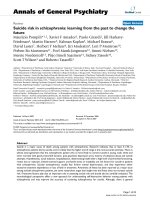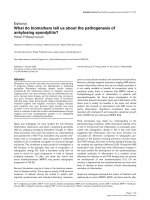Báo cáo y học: " Peptide P5 (residues 628–683), comprising the entire membrane proximal region of HIV-1 gp41 and its calcium-binding site, is a potent inhibitor of HIV-1 infection" pptx
Bạn đang xem bản rút gọn của tài liệu. Xem và tải ngay bản đầy đủ của tài liệu tại đây (482.55 KB, 12 trang )
BioMed Central
Page 1 of 12
(page number not for citation purposes)
Retrovirology
Open Access
Research
Peptide P5 (residues 628–683), comprising the entire membrane
proximal region of HIV-1 gp41 and its calcium-binding site, is a
potent inhibitor of HIV-1 infection
Huifeng Yu
1,2
, Daniela Tudor
1,2
, Annette Alfsen
1,2
, Beatrice Labrosse
3,4
,
François Clavel
3,4
and Morgane Bomsel*
1,2
Address:
1
Entrée Muqueuse du VIH et Immunité Muqueuse, (Mucosal Entry of HIV-1 and Mucosal Immunity), Departement de Biologie
Cellulaire, (Cell Biology Department), Institut Cochin, Université Paris Descartes, CNRS (UMR 8104), 22 rue Mechain, 75014 Paris, France,
2
Inserm, U567, Paris, France,
3
Inserm U552 Hopital Bichat-Claude Bernard, 46, rue Henri Huchard, 75018 Paris, France and
4
Université Paris
Diderot, Paris, France
Email: Huifeng Yu - ; Daniela Tudor - ; Annette Alfsen - ;
Beatrice Labrosse - ; François Clavel - ;
Morgane Bomsel* -
* Corresponding author
Abstract
The membrane proximal region (MPR) of the transmembrane subunit, gp41, of the HIV envelope
glycoprotein plays a critical role in HIV-1 infection of CD4
+
target cells and CD4-independent
mucosal entry. It contains continuous epitopes recognized by neutralizing IgG antibodies 2F5, 4E10
and Z13, and is therefore considered to be a promising target for vaccine design. Moreover, some
MPR-derived peptides, such as T20 (enfuvirtide), are in clinical use as HIV-1 inhibitors. We have
shown that an extended MPR peptide, P5, harbouring the lectin-like domain of gp41 and a calcium-
binding site, is implicated in the interaction of HIV with its mucosal receptor. We now investigate
the potential antiviral activities of P5 and other such long MPR-derived peptides. Structural studies
of gp41 MPR-derived peptides using circular dichroism showed that the peptides P5 (a.a.628–683),
P1 (a.a.648–683), P5L (a.a.613–683) and P7 (a.a.613–746) displayed a well-defined α-helical
structure. Peptides P5 inhibited HIV-1 envelope mediated cell-cell fusion and infection of peripheral
blood mononuclear cells by both X4- and R5-tropic HIV-1 strains, whereas peptides P5 mutated in
the calcium binding site or P1 lacked antiviral activity, when P5L blocked cell fusion in contrast to
P7. Strikingly, P5 inhibited CD4-dependent infection by T20-resistant R5-tropic HIV-1 variants.
Cell-cell fusion studies indicated that the anti-HIV-1 activity of P5, unlike T20, could not be
abrogated in the presence of the N-terminal leucine zipper domain (LZ). These results suggested
that P5 could serve as a potent fusion inhibitor.
Introduction
In the vast majority of cases, HIV-1 transmission occurs at
mucosal sites. The initial target cells for HIV-1 at mucosal
sites include epithelial cells (CD4-negative) in simple
monostratified mucosa (rectum, gastrointestinal tract,
endo-cervix) and dendritic cells in pluristratified mucosa
(vagina, exo-cervix, foreskin). Entry of HIV-1 into both
types of cells is mediated by the cooperative interaction
Published: 16 October 2008
Retrovirology 2008, 5:93 doi:10.1186/1742-4690-5-93
Received: 9 July 2008
Accepted: 16 October 2008
This article is available from: />© 2008 Yu et al; licensee BioMed Central Ltd.
This is an Open Access article distributed under the terms of the Creative Commons Attribution License ( />),
which permits unrestricted use, distribution, and reproduction in any medium, provided the original work is properly cited.
Retrovirology 2008, 5:93 />Page 2 of 12
(page number not for citation purposes)
between both HIV-1 envelope subunits, gp120 and gp41,
and galactosyl ceramide (GalCer) [1-3], thereby inducing
HIV endocytosis in target cells and subsequent transcyto-
sis or transfer to susceptible CD4
+
T cells [4]. We have pre-
viously demonstrated that the peptide P1 (a.a. 649–683)
derived from the membrane proximal region (MPR) of
gp41 acts as a galactose-specific lectin in binding to Gal-
Cer, the HIV-1 mucosal receptor expressed on both epi-
thelial and dendritic cells [2,4,5]. In this case, HIV-1
neither fuses with nor infects target cells.
In contrast, CD4
+
T cells are infected by HIV-1, leading to
HIV spread. Infection is mediated by the HIV-1 envelope
glycoproteins gp120/gp41, which trigger fusion between
viral and cellular membranes, resulting in productive
infection. Viral replication then causes rapid CD4
+
T cell
depletion, essentially at mucosal sites. Upon binding to
CD4 and the co-receptor CCR5/CXCR4, gp120 undergoes
serial conformational changes that allow the insertion of
the gp41 fusion peptide into the target cell membrane and
formation of the pre-hairpin structure. Subsequent forma-
tion of a hairpin structure (six-helix-bundle) promotes
fusion between viral and cellular membranes [6,7]. The
hydrophobic region of the MPR plays an important role in
this conformational change [8,9]. The membrane fusion
step can be inhibited by peptides mimicking the sequence
of N-terminal (NHR) or C-terminal (CHR) heptad
repeats, which block the association of the NHR and CHR
regions, thus preventing hairpin formation [10].
In sum, the highly conserved MPR of gp41, which con-
tains continuous epitopes recognized by broadly neutral-
izing antibodies 2F5 [11], 4E10 [12] and Z13 [13],
appears to be essential for both CD4-dependent target cell
infection and CD4-independent mucosal entry of HIV-1.
The MPR, along with the C-terminal cytoplasmic tail, is
known to be determinant for envelope glycoprotein (Env)
incorporation into virions and virus infectivity [9,14].
In general, peptides from the CHR region (C-peptides)
display higher inhibitory activity than peptides from the
NHR region (N-peptides) [15]. The first approved fusion
inhibitor drug, Enfuvirtide (T20, a.a.640–673), displays
an IC50 value in the nM range against some laboratory-
adapted HIV-1 isolates in vitro, and excellent efficacy in
clinical trials [16-18]. However, it leads in vivo to the gen-
eration of viral escape mutants, restricting its potential use
for therapeutic purposes [19].
Peptide P1 is the minimal region of the MPR allowing
interaction with GalCer. It contains three subdomains
essential for its lectin activity, namely, the CHR which is
rich in glutamic acid and highly negatively charged, the
central hexapeptide ELDKWA epitope recognized by the
potent and broadly neutralizing 2F5 IgG [11], and a
hydrophobic tryptophan-rich region recognized by the
other gp41-specific broadly neutralizing IgG, 4E10 and
Z13 [12,13]. Our recent biophysical studies [20] of pep-
tides P1 and P5 (a.a.628–683), revealing an extended
structure comprising not only the MPR peptide, but also
the gp41 calcium-binding site (a.a.628–648) in its N-ter-
minal portion [21], suggested that the affinity of gp41 for
GalCer is dependent on the conformation of its lectin-
binding site, which depends upon its environment. In
particular, in the presence of calcium P5 undergoes a sec-
ondary structural change that decreases its affinity for Gal-
Cer.
In an effort to develop an effective microbicide, vaginal
application of a peptide (C52L) similar to P5 [22], in
combination with the CCR5 ligand CMPD167 or the
entry inhibitor BMS378806, afforded protection against
infection in Rhesus macaques upon vaginal challenge
with SHIV.
As P1 and P5 comprise a larger portion of the MPR and
were crucial for HIV entry in mucosa, we have evaluated
in the present study their antiviral activity against HIV-1-
mediated fusion and infection in comparison with T20,
which comprises a more restricted region of the MPR.
In the present study, the anti-HIV-1 activity and the struc-
ture of the different MPR-derived peptides, including P1
(a.a.648–683), P5 (a.a.628–683), P5L (a.a.613–683) and
P7 (a.a.613–746), were investigated. The schematic repre-
sentation and the sequence of these peptides are pre-
sented in Figure 1. The P5L peptide comprises P5 and a
caveolin-binding domain -1, the target of neutralizing
antibodies [23]. The P7 peptide contains the transmem-
brane region (TM) and part of the C-terminal tail, the lat-
ter including sequences reported to be the target of
neutralizing antibodies [24,25].
Methods
Materials
Polymerase and deoxynucleoside triphosphates (dNTPs)
for PCR amplification and isopropyl-beta-D-thiogalacto-
pyranoside (IPTG) were purchased from Invitrogen. IgG
sepharose was from Amersham Bioscience (Paris, France).
Bacterial cells (E. coli Rosetta™) were from Novagen. The
eukaryotic expression vector pGEV, designed for improv-
ing expression [26], was provided by Drs. F. Toma and P.
Curmi (Evry-Val d'Essonne University, Evry, France).
Materials used to purify PCR products were from QIAGEN
(Paris, France). Ligase and restriction enzymes (NcoI and
NotI) were from New England Biolabs, Inc (MA, USA). All
other chemicals were of the highest purity commercially
available (Sigma).
Retrovirology 2008, 5:93 />Page 3 of 12
(page number not for citation purposes)
Chemically synthesized peptides P5 (628–683), P5
mutated in the calcium binding site (Δ Ca2+ bs-P5, 629–
683), P1 (649–683) and LZ (560–594) were from
NeoMPS (France) and Eurogentec (Belgium) with a purity
>90%. Peptides T20 (# 9845) and N36 (546–581) (#
9773) were obtained from the AIDS Research and Refer-
ence Reagent Program, NIAID.
Construction, expression and purification of recombinant
peptides
The coding sequence of all peptides was PCR amplified by
use of a pair of synthetic oligonucleotides chosen in refer-
ence to the cDNA sequence of HIV
HXB2
. The PCR products
were subsequently digested with NcoI/NotI and cloned
into the pGEV vector, previously digested at the same
sites. The sequences of recombinant constructs were con-
firmed by restriction enzyme analysis and DNA sequenc-
ing using the dideoxy chain termination method.
The recombinant plasmids pGEV-P1, P5, P5L and P7
bearing the transmembrane region (TM) were trans-
formed into E. coli Rosetta™ (Novagen) competent cells by
the heat shock procedure. One liter of LB medium (con-
taining 100 μg/mL ampicillin) was inoculated with 5 mL
of a fresh overnight culture and incubated at 37°C. The
cultures were induced by the addition of 1 mM isopropyl-
β-D-thiogalactopyranoside (IPTG) at an OD600 of 0.5–
0.7, and further incubated for 3 h or overnight, under the
same conditions. The cells were then harvested by centrif-
ugation at 6,000 rpm for 20 min at 4°C. The pelleted cells
were suspended in 100 mL of TST Buffer (50 mM Tris, 150
mM NaCl, 0.05% Tween-20; pH = 7.6), and sonicated.
Cell debris was eliminated by centrifugation at 10,000 × g
for 20 min. The soluble fraction was incubated for 2 h at
4°C in 5 ml of IgG-Sepharose that had been equilibrated
in Buffer TST. The beads were washed once with 10 col-
umn volumes of TST Buffer, and subsequently 3 times
with 10 column volumes of washing buffer (5 mM
NH
4
Ac, pH = 5.0). Peptides were then eluted with 0.5 M
CH
3
COOH, pH = 3.3 and immediately dialyzed against
water or PBS, overnight.
Reverse Phase Chromatography
Reverse phase high performance liquid chromatography
(RP HPLC) was performed using a C18 column. Peptides
were eluted with buffer A (0.1% trifluoroacetic acid, 5%
acetonitrile) for 15 min followed by a linear gradient from
0 to 100% of buffer B (0.1% trifluoroacetic acid, 80% ace-
tonitrile) over 5 min, while monitoring by absorbance at
280 or 218 nm. The peaks corresponding to peptides P1
or P5 were further analyzed using MALDI-TOF Mass Spec-
trometry [27].
Far-UV circular dichroism measurements
Far-UV circular dichroism (CD) was performed using 10
μM of each peptide solution in PBS. Each spectrum was
Schematic representation of the HIV-1 gp41 domainsFigure 1
Schematic representation of the HIV-1 gp41 domains. Gp41 comprises cytoplasmic, transmembrane (TM) and extra-
cellular domain. Important functional extracellular-domains of gp41 include the fusion peptide (FP), N-terminal and C-terminal
heptad repeats (NHR or HR1 and CHR or HR2, respectively). Peptides used in the present study are as follows: P5 (a.a.628–
683), Δ Ca2+ bs-P5 (a.a. 628–683) corresponding P5 mutated (bold characters) in the calcium-binding site, P1 (a.a. 648–683),
P5L (a.a. 613–683), P7 (a.a.613–746), N36 (a.a. 546–581) LZ (a.a. 560–594). T-20 (a.a. 638–673) is a well-described HIV-1
fusion inhibitor (Enfurvirtide). The residues are numbered according to their position in gp160 of HIV-1
HXB2
. The N-ter of T20
(aa 638) located within the calcium-binding site and that of P1 (a.a. 649) are indicated (grey arrow head). The calcium-binding
site in P5 and P5 (L) are underlined.
T20(a.a.638-673):
YTSLIHSLIE
YTSLIHSLIEESQNQQEKNEQELLELDKWASLWNWF
P1 (a.a.649-683): SQTQQEKNEQELLELDKWASLWNWFDITNWLWYI
P5 (a.a.628-683): WM
EWDREINNYTSLIHSLIE
EWDREINNYTSLIHSLIEESQNQQEKNEQELLELDKWASLWNWFNITNWLWYIK
Ca2+ bs-P5(a.a.629-83):WMAWARTINNKTSLIHSLIEESQNQQEKNEQELLELDKWASLWNWFNITNWLWYIK
P5(L) (a.a.613-683) ):
SWSNKSLEQIWNHTTWM
EWDREINNYTSLIHSLIE
EWDREINNYTSLIHSLIEESQNQQEKNEQELLELDKWASLWNWFNITNWLWYIK
P7 (a.a.613-746): P5(L) + LFIMIVGGLVGLRIVFAVLSIVNRVRQGYSPLSFQTHLPTPRGPDRPEGIEEEGGERDRDRSI
N36(546-581): AGIVQQQQQLLDVVKRQQELLRLTVWGTKNLQTRVT
LZ (560-594):
AQQHMLQLTVWGIKQLQARVLAVERYLKDQQLLA
N-ter
FP NHR Loop TM
CHR
Cytoplasmic
592512 542 665 683623 705 856
W
C-ter
E-rich
638
649
Ca
2+
binding site
-rich
Retrovirology 2008, 5:93 />Page 4 of 12
(page number not for citation purposes)
recorded from 260 nm to 190 nm at 25°C by using a Jasco
CD spectrophotometer (Jasco, Japan) with a cell path
length of 0.05 cm. Spectra were collected as an average of
three scans, with a scan speed of 20 nm/min and a
response time of 2 sec. The control (solvent) CD spectra
were subtracted to eliminate background effects. Data
were reported [28] in millidegrees and converted to molar
ellipticity [θ] in units as follows: degree cm
2
dmol
-1
. The
percentage of α-helical content was estimated by assum-
ing that a [θ]222 value of -33000 deg cm
2
dmol
-
1
corresponds to 100% α-helix.
Construction of viruses carrying primary envelope
glycoproteins
We constructed viruses bearing the envelope glycopro-
teins derived from virus populations present before and
during T20 treatment of a patient who received T20 as part
of a salvage therapy, as we reported earlier. Hence, a por-
tion of the envelope gene encoding gp120 and the ectodo-
main of gp41 (nt 6480 to 8263), previously subcloned
into the pCR2.1TOPO vector, was amplified with primers
that allowed the introduction of two restriction enzyme
sites (AgeI at position 6346 and NheI at position 8287)
and digested. Each chimeric proviral clone was obtained
by replacing the AgeI-NheI fragment of a modified pNL4-
3 vector (nt 6346 to 8287 in pNL4-3) by a AgeI-NheI PCR
fragment amplified from the envelope subclone.
Sequences of oligonucleotides used for PCR and site-
directed mutagenesis can be provided upon request. The
pre-T20 virus expressing envelope glycoproteins derived
from the pretherapy virus population did not carry the
well characterized T20-resistance mutations, which are for
the most part located between residues 36 to 45 of the
NHR region of gp41 [Sista, 2002 #47] [29]. The envelope
proteins of the two other viruses, T20-1 and T20-2, as well
as the virus populations from which they were derived,
expressed the V38A resistance mutation [30].
Cells and virus stocks
Hela-CD4-LTR-LacZ cells (P4.2, kindly provided by Dr.
M. Alizon, Institut Cochin, Paris, France) stably express
human CD4 and CXCR4, as well as the β-galactosidase-
encoding gene lacZ under the transcriptional control of
the HIV-1 long terminal repeat (LTR), which is activated
by HIV-1 Tat [31]. Hela-env-Lai cells stably express HIV-
Lai env genes from X4 virus and Tat in the cytosol. All cell
lines were cultured in Dulbecco's modified Eagle medium
(DMEM, GIBCO) containing physiological concentration
of calcium (1.8 mM) supplemented with 10% heat-inacti-
vated fetal calf serum (FCS), 100 U/ml penicillin, 100 mg/
ml streptomycin and 2 mM glutamine. The human cell
line U373MG-CD4-CCR5-LTR-lacZ, stably expressing the
human receptors CD4 and CCR5 and bearing the lacZ
indicator cassette [32], was propagated in DMEM supple-
mented with 60 μg/ml penicillin, 100 μg/ml streptomy-
cin, and 10% heat-inactivated fetal calf serum. Peripheral
blood mononuclear cells (PBMC) were isolated from
heparinized human blood by Ficoll (Ficoll-Paque PLUS,
Amersham Bioscience) gradient centrifugation and resus-
pended in fetal calf serum supplemented with 10%
DMSO for storage in liquid nitrogen PBMC were activated
by incubation in RPMI 1640 medium containing 5 μg/ml
phytohemagglutinin-L (PHA-L, Sigma), 100 U/ml penicil-
lin, 100 mg/ml streptomycin, 2 mM glutamine and 10%
FCS. After three days of incubation with PHA, cells were
washed and used for infection. All cells were cultured in
5% CO
2
incubators at 37°C. Stocks of HIV-1 strains JRCSF
(R5 virus) and Lai (X4 virus) were produced by transfec-
tion of 293 T cells by the calcium phosphate method and
stored at -80°C [4]. Chimeric HIV-1 particles expressing
the gp120 and gp41 ectodomain of patient origin and the
cytoplasmic domain of gp41 from pNL4.3 were produced
as previously described [30]. Culture supernatants were
collected 40 h after transfection. HIV-1 p24 antigen pro-
duction was quantified for each viral stock by enzyme-
linked immunosorbent assay (Kit p24 Innogen, Innoge-
netics/Ingen).
HIV-1 env-mediated cell-to-cell fusion assay
Hela-env-Lai cells were seeded in 48-well plates (10
5
cells
per well) in the presence of peptides (P1, P5, P5L, P7,
T20) at concentrations ranging from 50 to 1000 nM. Fif-
teen minutes later, target cells (HeLa P4.2) were added to
the wells (10
5
per well) and co-cultured for 6 h at 37°C.
Then, cell-cell fusion was monitored by beta-galactosidase
assay [33]. Briefly, cells were lysed in 80 μl of lysis buffer
(5% NP40 in PBS without CaCl
2
and MgCl
2
) for 10 min
and then centrifuged at 10,000 g for 5 min at 4°C. Equal
volumes (50 μl) of lysate and reaction buffer (120 mM
Na
2
HPO
4
, 80 mM NaH
2
PO
4
, 2 mM MgSO
4
, 20 mM KCl,
10 mM β-mercaptoethanol, 16 mM CPRG (chlorophenol
red-β-D-galactopyranoside, Roche, France) were com-
bined and incubated for 60 min at room temperature in
the dark. The absorbance at 590 nm of each sample was
measured.
Neutralization of HIV-1 infection of PBMC
Neutralization of HIV-1 infectivity for PBMC was per-
formed as previously described [34] by analysing intracel-
lular staining of p24 Ag after a single round of infection.
Briefly, equal volumes (25 μl) of HIV-1
Lai
or HIV-1
JRCSF
virus (the amount of virus added per well corresponds to
50 ng of p24) and peptides T20, P1 or P5 at the indicated
concentration were incubated together for 1 h at 37°C.
PHA-stimulated PBMC (25 μl, 2 × 10
5
cells/well) were
added to the mixture. After overnight incubation, 100 μl
of culture medium containing 20 U/ml of IL-2 were added
and cells were cultured for an additional 24 h at 37°C. For
intracellular p24 Ag staining, cells were fixed with 4%
paraformaldehyde for 20 min, permeabilized with 0.05%
Retrovirology 2008, 5:93 />Page 5 of 12
(page number not for citation purposes)
saponin and stained with a fluorescent anti-p24 mAb (PE-
anti-p24, KC57 clone, Beckman Coulter, Hialeah, FL) as a
1/160 dilution in 1% BSA, 0.05% saponin in PBS (pH =
7.4) for 15–20 min at 4°C. The percentage of p24 positive
cells was monitored by flow cytometry (FACScalibur with
the XL software) by gating 20,000 events on the living cell
population identified by forward- and side-scatter param-
eters.
Inhibition of T20-resistant HIV-1 strains by P5 and T20
Two T20-sensitive (pre- Enfurvitide (ENF) and JRCSF) and
two T20-resistant strains (ENF-1 and ENF-2) were assayed
for their susceptibility to P5 and T20. These assays were
performed as previously described [30]. Two days before
infection, U373MG-CD4-CCR5-LTR-lacZ cells were
seeded into 96-well plates at a density of 2,000 cells/well.
Infection with 10 ng of p24/well of fresh viral suspension
was carried out in triplicate, in the absence or the presence
of increasing concentrations of T20 (from 1 to 3,3750
nM) (T20; American Peptide Company, Inc), and of P5
(from 1 to 2,000 nM). Forty hours after infection, cells
were lysed using 100 μl/well of lysis buffer (5 mM MgCl2
and 0.1% NP-40 in 1× phosphate-buffered saline), prior
to addition of 100 μl/well of chromogenic substrate (6
mM chlorophenol red-β-D-galactopyranoside; CPRG,
Roche) in lysis buffer. The concentrations of T20 inhibit-
ing virus infectivity by 50% (IC
50
values) were calculated
by using the median-effect equation [35].
Binding of Peptides to CD4
+
-target cells
Binding of peptides was evaluated using either the lym-
phocytic cell line CD4
+
- CEM-NK
r
(NK-resistant) cells
(NIH AIDS Reagent Programm, USA)or PHA-activated
CD4
+
T cells purified from peripheral blood of 5 healthy
donors using human CD4
+
T cells enrichment kit (Stem-
Cell Technologies Inc., France). 5 × 10
5
cells were incu-
bated with indicated concentrations of peptide for 1 h at
room temperature in a total volume of 50 microliter/μl of
RPMI 10%FCS. After 2 wahses in cold medium, bound
peptide was detected with the human IgG 2F5 (10 microg/
μg), or irrelevant human IgG as control, for 1 h at 37°C
followed anti-human IgG-FITC mAb (1:1000, Jackson
ImmunoResearch, France). Binding of peptides to CD4
+
cells was evaluated by flow cytometry (FACSCalibur, Bec-
ton Dickinson) on 10
4
events, gated by forward and side
scatter and analyzed for FL1 (FITC channel) using the
Cytomix RXP software. Data are presented as peptide-
bound cells % total gated cells to which nonspecific back-
ground evaluated with the control IgG was deduced
(background value less than 10% of the total counts).
Results and discussion
In previous studies, we have investigated the structure-
function relationship of long synthetic peptides derived
from the extracellular domain of gp41. Such long peptides
are highly hydrophobic and not easy to produce by chem-
ical synthesis. Furthermore, the role of the transmem-
brane region of gp41 on the MPR structure and function
cannot be analyzed. We therefore chose to express the
gp41-derived peptides P1, P5, P5L and P7 in fusion with
a cleavable carrier by using a prokaryote expression vector
(pGEV) (see Additional file 1).
Secondary structure analysis of gp41-derived peptides by
far UV CD spectra
CD spectroscopy is a practical and efficient method for
secondary structure characterization of a protein or pep-
tide. CD spectra of the synthetic peptides P1, P5, and
recombinant peptides P5L and P7, at a concentration of
10 μM and in a pH 7.2 buffer, displayed a positive peak
after 195 nm and two negative maxima at 208 nm-222
nm, characteristic of α-helices (Figure 2). Quantification
of the α-helical content of these peptides indicated that
the peptides P5 and P5L exhibited higher helical content
(49.9% and 56.6% respectively) than peptides P1 and P7
(30.3% and 34.5%, respectively).
In order to compare the effect of the addition of NHR pep-
tides to P5 and P1 structure with the one described for
T20, (T20+N46) [36], CD spectra of P1 or P5+LZ have
been obtained. For both peptides the molar ellipticity [θ]
at 222 nm appeared to increase, from -18.05 to -21.32 for
the LZ+P1, or from -19.45 to -23.12 for LZ+P5, indicating
a slight increase in the α-helical content (Table 1). Upon
mixing peptides N36 with P1 or P5, the molar ellipticity
at 222 nm was just the sum of the spectra of N36 and P1
or P5. This is in agreement with results obtained when
T20 was mixed with NRH peptides [36].
P5, comprising P1 and the gp41 calcium-binding site,
inhibits HIV-1 env mediated-cell fusion and infection
Cell fusion experiments are convenient assays for analysis
of the mechanism by which peptides inhibit virus entry
into host cells. Hela-CD4-LTR-LacZ (P4.2) cells stably
express the human CD4 molecule, CXCR4 and long ter-
minal repeat (LTR) driven lacZ gene. Hela-env-Lai cells
stably express HIV-Lai envelope glycoproteins gp120 and
gp41, and the HIV-1 transactivator Tat. Fusion of Hela-
Env-Lai cells and P4.2 cells results in transferring Tat to
P4.2 cell cytosol. Tat in turn, transactivates the LTR and
initiates transcription of the lacZ gene. The extent of
fusion is directly related to β-galactosidase activity in cell
lysates [31].
Different concentrations (≤ 1 μM) of peptides were incu-
bated with HeLa-env-Lai cells in culture medium
(DMEM) that contained calcium and magnesium, prior to
addition of the P4.2 cells. As shown in Figure 3a and Table
2, P5, P5L and T20 substantially inhibited cell fusion, in
contrast to P1, P7 or the peptide LZ comprising the gp41
Retrovirology 2008, 5:93 />Page 6 of 12
(page number not for citation purposes)
leucine zipper, which has been reported to be devoid of
antiviral activity [17]. Moreover, the P5 peptide encom-
passing the gp41 lectin- and calcium-binding sites, exhib-
ited the highest antiviral activity of all peptides tested in
the calcium-containing medium (Table 2).
Peptides LZ and N36 at 1 μM exhibit negligible inhibition
of cell-cell fusion. The presence of LZ did not substantially
modify the efficiency with which P5 inhibited cell-cell
fusion, in contrast with T20 (Table 2) and in agreement
with the data on the structure of the peptides (Table 1).
The antiviral properties of peptides P5, P1 and T20 were
tested against infection of PBMC by X4- (HIV-1
Lai
) and
R5-tropic (HIV-1
JRCSF
) strains of HIV-1. As shown in Fig-
ure 3b, and 3c, at 1 μM the P5 and T20 peptides had an
inhibitory activity greater than 90% for both X4 and R5
virus infection. IC50 of infection of PBMC by and R5-
tropic (HIV-1
JRCSF
) strains was 20% lower for P5 as com-
pared to T20. Strikingly, P5 mutated in the calcium-bind-
ing site (Δ Ca2+ bs-P5) had no antiviral activity,
suggesting that the calcium-binding site of P5, absent
from T20 is determinant in P5 antiviral activity. In con-
trast, P1 did not inhibit HIV-1 infection of PBMC under
the same conditions.
CD spectra of peptides P1, P5, P5L, P7Figure 2
CD spectra of peptides P1, P5, P5L, P7. Far-UV CD spectra were all recorded at room temperature, with a path-length
of 0.05 cm. Peptide concentration was 10 microM in PBS, pH 7.2. For each spectrum, the medium base line has been sub-
tracted and mean residue ellipticity (degree
.
centimeter
2.
decimole
-1
) versus wavelength is shown. Every measurement in this fig-
ure was performed three times and one representative set of spectra is shown.
[
x10
-3
deg
cm
2
dmol
-1
)
-20
-10
0
10
20
190 200 210 220 230 240 250 260
P1
P5
P7
P5 (L)
Wavelength (nm)
Retrovirology 2008, 5:93 />Page 7 of 12
(page number not for citation purposes)
The mechanisms underlying the anti-HIV-1 activity of T20
remain unclear. It has been proposed that T20 directly
interacts with gp41 and gp120, thereby inhibiting viral
and cellular membrane fusion [36,37]. Moreover, the
tryptophan-rich region (a.a.666–673) in T20 could inter-
act with the membrane surface, thereby blocking mem-
brane fusion at a post-lipid mixing stage [36,38].
Although T20 is successfully used in the clinical setting,
drug resistant mutants have been reported [19,29], and in
particular in the 3 amino acid GIV motif, located in the
NHR of gp41, an important binding site for T20.
Peptides derived from the CHR region of the gp41 ectodo-
main possess strong anti-HIV activity by virtue of interact-
ing with the coiled-coil motif of gp41 [15,39]. Peptide P5
derived from this domain comprises three additional
non-polar residues, Trp628, Trp631 and Ile635, as com-
pared with T20 or P1, which could increase the binding
affinity of the peptide for a hydrophobic cavity in the
coiled-coil region. Additionally, the calcium binding site
present in P5 but not in T20 and P1, most likely allow the
peptide to adopt an inhibitory conformation in physio-
logical conditions where calcium concentration reaches
the micromolar range [20]. Moreover, C-peptides con-
taining the hydrophobic cavity-binding region (a.a.628–
635) are much less sensitive to the emergence of resistant
virus than T20, which lacks this region [29].
We next evaluated the respective ability of P5 and T20 to
bind directly to the CD4
+
-target cell. As shown on figure
4, P5 bound specifically in a concentration-dependent
manner in the micro-molar range to either a CD4
+
lym-
phocyte cell line, CEM as well as to primary human CD4
+
T cells. In contrast, T20 was unable to bind these target
cells. These results indicated that T20 and P5 interact dif-
ferently with the target cell, inferring that each peptide
exerts its antiviral activity using a different mechanism.
Furthermore, P5 mutated in the calcium-binding site
(P5m) was also unable to interact with CD4
+
-target cells,
indicating that P5 binding to target cells was calcium
dependent.
Altogether these data confirm that T20 and P5 exhibit
antiviral activities by different mechanism, and that P5
specific activity is calcium dependent.
P5 inhibits replication of T20-resistant HIV-1 strains
Since there were significant differences in the anti-HIV
activities of P5 and T20, we sought to determine whether
P5 is able to inhibit replication of HIV-1 strains resistant
to T20. Two T20-sensitive (pre-ENF and JRCSF) and two
T20-resistant strains (ENF-1 and ENF-2), with well-
defined genetic mutations conferring the resistance, were
used in our experiments [30]. The envelope of two T20-
resistant strains, ENF-1 and ENF-2, were cloned from virus
carried by the patient undergoing T20 treatment that
eventually failed. They were compared with the envelope
of virus recovered from the patient prior to T20 treatment
(pre-ENF), and with that of JRCSF. We found that both P5
and T20 were active against T20-sensitive strains, but that
P5 was more potent than T20, consistently with our obser-
vations (section 3.2) regarding the inhibition of infection
of PBMCs by JR-CSF or Lai virus. More importantly, P5
showed strong inhibitory activities against all T20-resist-
ant strains with IC50 ranging from 2 to 9 nM, while T20
failed to inhibit even at concentrations as much as 250- to
2000-fold higher (Figure 5). These results suggest that P5
could be used as an alternative fusion inhibitor for treat-
ment of patients with HIV-1/AIDS, in particular those
infected by T20-resistant variants.
Several non-exclusive factors may explain the strong anti-
HIV-1 activity of P5 reported here. Amino acids 628 to
663 of peptide P5, containing the calcium-binding site,
are essential for binding to the NHR region. It may over-
come the interaction with the three non-polar residues
GIV that uses T20 for direct interaction with viral gp41
NHR, thereby disrupting the six-helix bundle formation.
Furthermore, it would explain how P5 exhibited an anti-
viral activity against the T20-resistant viruses ENF-1 and -
2 that lack this GIV motif. P5 also comprises a lipid-bind-
ing domain (666–673) essential for maintaining the anti-
HIV-1 activity of T20 [17,36]. In this regard P5 would be
Table 1: The α-helical content of P1 & P5 alone or in the
presence of N36 & LZ
[θ]
222
(10
-3
deg cm
2
dmol
-1
)
[θ]
222
(10
-3
deg cm
2
dmol
-1
)
N36 -6 LZ -4
P1 -11 P5 -15
P1+N36 -17 P1+LZ -21
P5+N36 -21 P5+LZ -23
a
T20 -2
b
T20+N46 -9
Note: Peptides were all chemically synthesized;
a
: from[20];
b
: from
[36]
Table 2: Inhibition of HIV-1 mediated cell-cell fusion by gp41
MPR derived peptides
IC50
g
(nM, Mean ± S.D.)
IC50
(nM, Mean ± S.D.)
N36 >1000 LZ > 1000
P1 913 ± 13.6 P1 + LZ 923.4 ± 11.7
T20 78 ± 5.6 T20 + LZ 579 ± 3.5
P5 60 ± 2. P5 + LZ 61 ± 1.5
P5L 90 ± 1.7 P7 560 ± 10.7
Note: Peptides P5L and P7 are recombinants the other chemically
synthesized
Retrovirology 2008, 5:93 />Page 8 of 12
(page number not for citation purposes)
Figure 3 (see legend on next page)
0
20
40
60
80
100
0 200 400 600 800 1000
[Peptide][nM]
Inhibiton of cell-cell fusion (%)
P5(L)
P1
P5
T20
P7
a.
b.
c.
0
20
40
60
80
100
0 200 400 600 800 1000
Peptide concentration (nM)
Inhibition of JRCSF infection PBMC(%)
T20
P1
P5
P5
Ca2+ bs -
P5
190
> 1000
240T20
IC50 (nM)
Ca2+ bs-P5
Inhibition of PBMC infection by JRCSF (%)
0.4%
T20 1 M
0.0%
P5 1 M
P1 1 M
2.4% 2.2%
control
Retrovirology 2008, 5:93 />Page 9 of 12
(page number not for citation purposes)
similar to other peptides from the C-terminal heptad
repeat that are thought to act as strong anti-HIV-1 activity
by binding directly to the virus, thereby preventing hair-
pin formation and subsequent inhibition of fusion
between viral and cellular membranes. Moreover, since
P5 harbors a calcium-binding site [20], in the presence of
extracellular calcium P5 might adopt a different confor-
mation due to the saturation of the calcium binding site.
Indeed, the P5 peptide, shown to be able to bind directly
to the target cell, whereas the mutated P5 did not bind,
could compete with the incoming viral particle and
thereby inhibit fusion. Accordingly, as shown on Fig. 3c, a
P5 peptide with mutation in the amino acids forming the
calcium-binding site [21] exhibited minimal inhibition of
CD4
+
T cell infection by the R5-tropic JR-CSF virus as
compared with wild type P5 (inhibition at a peptide con-
centration of 250 nM was negligible for mutated P5 (8%)
as compared to 65% for wild type P5). This suggests that
the superior antiviral activity of P5, as compared with T20,
could be attributable to the calcium-binding site confor-
mation along with the tryptophan-rich hydrophobic
region immediately adjacent to the viral membrane. These
a. HIV-1 env mediated cell-cell fusion inhibition assayFigure 3 (see previous page)
a. HIV-1 env mediated cell-cell fusion inhibition assay. Cells expressing the HIV-1 envelope were incubated with target
cells expressing HIV receptors in the presence of recombinant peptides P5 (black triangle), P1 (black square), P5L (black dia-
mond) and P7 (x), and compared with peptide T20 (open circle). After 6 h of co-culture, fusion was quantified by measuring
the beta–galactosidase activity after lysis of the cells. The values were expressed as the average (± S.D.) of three wells from
one representative experiment of three. b. Inhibition of human PBMC infection by HIV-Lai in the presence of P1, P5 and T20.
Inhibition of PBMC infection by HIV-Lai was evaluated by intracellular staining of p24 Ag. At 1 μM, peptides P5 and T20 exhib-
ited potent inhibition of PBMC infection by X4 virus. In contrast, P1, a shorter peptide devoid of the gp41calcium-binding site,
did not inhibit PBMC infection at the same concentration. c. Inhibition of human PBMC infection by HIV-
JRCSF
in the presence of
P1, P5 and T20. Percent of inhibition of PBMC infection by HIV-
JRCSF
evaluated as in Figure 3b by intracellular staining of p24 Ag.
Inset: IC50 are given in nM.
Binding of Peptides to CD4
+
-target cellsFigure 4
Binding of Peptides to CD4
+
-target cells. P5, P5 mutated in the calcium-binding site (P5m), and T20 at indicated concen-
trations were allowed to interact the CD4
+
-target cells: primary human CD4
+
T cells or the lymphocytic CD4
+
- CEM cell line.
Bound peptide were detected using the IgG 2F5 and analyzed by flow cytometry. Results are shown in a two-scale bar graph
(human CD4
+
T cells (left scale), CD4
+
- CEM cell line (right scale)) as peptide bound cells % the gated population, to which non
specific binding has been subtracted.
CD4
+
Tcells
(%)
CD4
+
-CEM
(%)
Retrovirology 2008, 5:93 />Page 10 of 12
(page number not for citation purposes)
structural elements could confer an efficient antiviral
activity, and raise the possibility that calcium plays a role
in peptide conformation and its direct interaction with
the membrane, either of the virus or the target cell.
In contrast, peptide P1 contains only a partial CHR region
without the calcium-binding site and the hydrophobic
cavity-binding domain and does not exhibit any anti-HIV-
1 activity. The low antiviral activities of P7 peptide indi-
cated that the C-terminal cytoplasmic tail in P7 did not
contribute to the antiviral activities. Previous research sug-
gested that C-peptides that had a low tendency to adopt a
helical conformation failed to bind to the coiled-coil
motif and in turn did not prevent gp41-mediated cell
fusion [40,41].
Accordingly, the CD analysis indicated that peptides P1
and P7 with low anti-HIV-1 activity exhibited lower heli-
cal content compared with peptides P5 and P5L with high
antiviral activity. The high helical content and the three
non-polar residues facing the hydrophobic cavity,
together with the structure of the calcium-binding site, are
therefore likely to be responsible for the high anti-HIV
activity of peptides P5.
In the present study, we found that the antiviral activities
of recombinant peptides P1, P5 and P5L were similar to
those of their chemically synthesized counterparts (not
shown), that pave the way for an easier development of
the use of long peptides, usually difficult and costly to
produce, as antivirals. Thus recombinant peptides hold
promise for HIV-1 salvage treatment in resource-poor set-
tings. Moreover, the expression of recombinant peptides
Inhibition of replication of T20-resistant HIV-1 strainsFigure 5
Inhibition of replication of T20-resistant HIV-1 strains. Inhibition of the replication of two T20-sensitive (pre-ENF,
JRCSF) and two T20-resistant strains (ENF-1 and ENF-2) by P5 was studied in comparison with T20. P5 (open symbols)
showed strong inhibitory activities against T20-resistant strains as compared with T20 (closed symbols). Sensitivity to P5 and
T20 was measured in a single-cycle assay. Each point represents the mean IC
50
value of at least three independent experiments
(bars represent standard errors).
10
0
10
1
10
2
10
3
10
4
IC 50 (nM)
Retrovirology 2008, 5:93 />Page 11 of 12
(page number not for citation purposes)
P1, P5 and P5L should enable structural analysis by NMR
under different conditions. In particular, study by NMR of
isotopically labeled recombinant P1 and P5 in the pres-
ence of liposomes of different lipid composition [42] and
of neutralizing antibodies should provide structural infor-
mation of use in HIV-1 vaccine design. However, genera-
tion of escape mutants have restricted the use of T20; and
that could apply to other currently approved anti HIV
medications. Furthermore, the use of peptides as thera-
peutics could also be restricted by immunogenicity and
half-life in circulation. Hence all these parameters need to
be met before a peptide can be a therapeutic.
Competing interests
The authors declare that they have no competing interests
Authors' contributions
HY participate to the conception of the study, carried out
the molecular biology, biophysical studies and neutraliza-
tion assays, and drafted the manuscript. DT participated
to the neutralization and binding assays. AA participated
in the design of the study and writing of the manuscript.
BL and FC performed the neutralization assays involving
ENF-resistant viruses. MB conceived of the study, and par-
ticipated in its design and coordination and writing of the
manuscript. All authors read and approved the final man-
uscript.
Additional material
Acknowledgements
We want to thank Prs. M. Ghomi and P.Y. Turpin for welcoming us in their
laboratory (BIOMOCETI, Evry) and allowing us to use of the Jasco CD
apparatus, Pr. B. Desmazieres and Dr. Alain for HPLC and Mass Spectrom-
etry analysis, and Dr. J. Richardson for English editing. We thank Pr P. A.
Curmi for providing the pGEV vector and helping us design recombinant
peptides. H.Y. and M.B. were supported by fellowships and grants from
ANRS and SIDACTION and FRM.
References
1. Bomsel M: Transcytosis of infectious human immunodefi-
ciency virus across a tight human epithelial cell line barrier.
Nat Med 1997, 3(1):42-7.
2. Alfsen A, Bomsel M: HIV-1 gp41 envelope residues 650–685
exposed on native virus act as a lectin to bind epithelial cell
galactosyl ceramide. J Biol Chem 2002, 277(28):25649-59.
3. Fantini J, Hammache D, Delezay O, Yahi N, Andre-Barres C, Rico-
Lattes I, Lattes A: Synthetic soluble analogs of galactosylcera-
mide (GalCer) bind to the V3 domain of HIV-1 gp120 and
inhibit HIV-1-induced fusion and entry. J Biol Chem 1997,
272(11):7245-52.
4. Magerus-Chatinet A, Yu H, Garcia S, Ducloux E, Terris B, Bomsel M:
Galactosyl ceramide expressed on dendritic cells can medi-
ate HIV-1 transfer from monocyte derived dendritic cells to
autologous T cells. Virology 2007, 362(1):67-74.
5. Alfsen A, Yu H, Magerus-Chatinet A, Schmitt A, Bomsel M: HIV-1-
infected blood mononuclear cells form an integrin- and
agrin-dependent viral synapse to induce efficient HIV-1 tran-
scytosis across epithelial cell monolayer. Mol Biol Cell 2005,
16(9):4267-79.
6. Eckert DM, Kim PS: Mechanisms of viral membrane fusion and
its inhibition. Annu Rev Biochem 2001, 70:777-810.
7. Chan DC, Kim PS: HIV entry and its inhibition. Cell 1998,
93(5):681-4.
8. Munoz-Barroso I, Salzwedel K, Hunter E, Blumenthal R: Role of the
membrane-proximal domain in the initial stages of human
immunodeficiency virus type 1 envelope glycoprotein-medi-
ated membrane fusion. J Virol 1999, 73(7):6089-92.
9. Salzwedel K, West JT, Hunter E: A conserved tryptophan-rich
motif in the membrane-proximal region of the human
immunodeficiency virus type 1 gp41 ectodomain is impor-
tant for Env-mediated fusion and virus infectivity. J Virol 1999,
73(3):2469-80.
10. Furuta RA, Wild CT, Weng Y, Weiss CD: Capture of an early
fusion-active conformation of HIV-1 gp41. Nat Struct Biol 1998,
5(4):276-9.
11. Muster T, Steindl F, Purtscher M, Trkola A, Klima A, Himmler G,
Ruker F, Katinger H: A conserved neutralizing epitope on gp41
of human immunodeficiency virus type 1. J Virol 1993,
67(11):6642-7.
12. Stiegler G, Kunert R, Purtscher M, Wolbank S, Voglauer R, Steindl F,
Katinger H: A potent cross-clade neutralizing human mono-
clonal antibody against a novel epitope on gp41 of human
immunodeficiency virus type 1. AIDS Res Hum Retroviruses 2001,
17(18):1757-65.
13. Zwick MB, Labrijn AF, Wang M, Spenlehauer C, Saphire EO, Binley
JM, Moore JP, Stiegler G, Katinger H, Burton DR, Parren PW:
Broadly neutralizing antibodies targeted to the membrane-
proximal external region of human immunodeficiency virus
type 1 glycoproteingp41. J Virol 2001, 75(22):10892-905.
14. Akari H, Fukumori T, Adachi A: Cell-dependent requirement of
human immunodeficiency virus type 1 gp41 cytoplasmic tail
for Env incorporation into virions. J Virol 2000, 74(10):4891-3.
15. Debnath AK: Progress in identifying peptides and small-mole-
cule inhibitors targeted to gp41 of HIV-1. Expert Opin Investig
Drugs 2006, 15(5):465-78.
16. Jiang S, Lin K, Strick N, Neurath AR: HIV-1 inhibition by a pep-
tide. Nature 1993, 365(6442):113.
17. Wild CT, Shugars DC, Greenwell TK, McDanal CB, Matthews TJ:
Peptides corresponding to a predictive alpha-helical domain
of human immunodeficiency virus type 1 gp41 are potent
inhibitors of virus infection. Proc Natl Acad Sci USA 1994,
91(21):9770-4.
18. Matthews T, Salgo M, Greenberg M, Chung J, DeMasi R, Bolognesi D:
Enfuvirtide: the first therapy to inhibit the entry of HIV-1
into host CD4 lymphocytes. Nat Rev Drug Discov 2004,
3(3):215-25.
19. Lu J, Deeks SG, Hoh R, Beatty G, Kuritzkes BA, Martin JN, Kuritzkes
DR: Rapid emergence of enfuvirtide resistance in HIV-1-
infected patients: results of a clonal analysis. J Acquir Immune
Defic Syndr 2006, 43(1):60-4.
20. Yu H, Alfsen A, Tudor D, Bomsel M: The binding of HIV-1 gp41
membrane proximal domain to its mucosal receptor, galac-
tosyl ceramide, is structure-dependent. Cell Calcium 2008,
43:73-82.
21. Ebenbichler CF, Stoiber H, Schneider R, Patsch JR, Dierich MP:
The
human immunodeficiency virus type 1 transmembrane gp41
protein is a calcium-binding protein and interacts with the
putative second-receptor molecules in a calcium-dependent
manner. J Virol 1996, 70(3):1723-8.
22. Veazey RS, Klasse PJ, Schader SM, Hu Q, Ketas TJ, Lu M, Marx PA,
Dufour J, Colonno RJ, Shattock RJ, Springer MS, Moore JP: Protec-
tion of macaques from vaginal SHIV challenge by vaginally
delivered inhibitors of virus-cell fusion. Nature 2005,
438(7064):99-102.
Additional File 1
Expression and purification of recombinant peptides. The data provided
describe in details the methodology for expression and purification of the
various recombinant fusion peptides used in the study.
Click here for file
[ />4690-5-93-S1.pdf]
Publish with BioMed Central and every
scientist can read your work free of charge
"BioMed Central will be the most significant development for
disseminating the results of biomedical research in our lifetime."
Sir Paul Nurse, Cancer Research UK
Your research papers will be:
available free of charge to the entire biomedical community
peer reviewed and published immediately upon acceptance
cited in PubMed and archived on PubMed Central
yours — you keep the copyright
Submit your manuscript here:
/>BioMedcentral
Retrovirology 2008, 5:93 />Page 12 of 12
(page number not for citation purposes)
23. Hovanessian AG, Briand JP, Said EA, Svab J, Ferris S, Dali H, Muller S,
Desgranges C, Krust B: The caveolin-1 binding domain of HIV-
1 glycoprotein gp41 is an efficient B cell epitope vaccine can-
didate against virus infection. Immunity 2004, 21(5):617-27.
24. Hollier MJ, Dimmock NJ: The C-terminal tail of the gp41 trans-
membrane envelope glycoprotein of HIV-1 clades A, B, C,
and D may exist in two conformations: an analysis of
sequence, structure, and function. Virology 2005,
337(2):284-96.
25. Kennedy RC, Henkel RD, Pauletti D, Allan JS, Lee TH, Essex M,
Dreesman GR: Antiserum to a synthetic peptide recognizes
the HTLV-III envelope glycoprotein. Science 1986,
231(4745):1556-9.
26. Gronenborn AM, Filpula DR, Essig NZ, Achari A, Whitlow M, Wing-
field PT, Clore GM: A novel, highly stable fold of the immu-
noglobulin binding domain of streptococcal protein G.
Science 1991, 253(5020):657-61.
27. Redeker V, Lachkar S, Siavoshian S, Charbaut E, Rossier J, Sobel A,
Curmi PA: Probing the native structure of stathmin and its
interaction domains with tubulin. Combined use of limited
proteolysis, size exclusion chromatography, and mass spec-
trometry. J Biol Chem 2000, 275(10):6841-9.
28. Chen YH, Yang JT, Chau KH: Determination of the helix and
beta form of proteins in aqueous solution by circular dichr-
oism. Biochemistry 1974, 13(16):3350-9.
29. Rimsky LT, Shugars DC, Matthews TJ: Determinants of human
immunodeficiency virus type 1 resistance to gp41-derived
inhibitory peptides. J Virol 1998, 72(2):986-93.
30. Labrosse B, Morand-Joubert L, Goubard A, Rochas S, Labernardiere
JL, Pacanowski J, Meynard JL, Hance AJ, Clavel F, Mammano F: Role
of the envelope genetic context in the development of enfu-
virtide resistance in human immunodeficiency virus type 1-
infected patients. J Virol 2006, 80(17):8807-19.
31. Dragic T, Alizon M: Different requirements for membrane
fusion mediated by the envelopes of human immunodefi-
ciency virus types 1 and 2. J Virol 1993, 67(4):2355-9.
32. Labrosse B, Brelot A, Heveker N, Sol N, Schols D, De Clercq E, Ali-
zon M: Determinants for sensitivity of human immunodefi-
ciency virus coreceptor CXCR4 to the bicyclam AMD3100. J
Virol 1998, 72(8):
6381-8.
33. Nussbaum O, Broder CC, Berger EA: Fusogenic mechanisms of
enveloped-virus glycoproteins analyzed by a novel recom-
binant vaccinia virus-based assay quantitating cell fusion-
dependent reporter gene activation. J Virol 1994,
68(9):5411-22.
34. Mascola JR, Louder MK, Winter C, Prabhakara R, De Rosa SC, Douek
DC, Hill BJ, Gabuzda D, Roederer M: Human immunodeficiency
virus type 1 neutralization measured by flow cytometric
quantitation of single-round infection of primary human T
cells. J Virol 2002, 76(10):4810-21.
35. Chou TC: The median-effect principle and the combination
index for quantitation of synergism and antagonism. In Syner-
gism and antagonism in chemotherapy Edited by: Chou TC, Rideout DC.
Academic Press, San Diego, Calif; 1991:61-102.
36. Liu S, Jing W, Cheung B, Lu H, Sun J, Yan X, Niu J, Farmar J, Wu S,
Jiang S: HIV gp41 C-terminal heptad repeat contains multi-
functional domains. Relation to mechanisms of action of
anti-HIV peptides. J Biol Chem 2007, 282(13):9612-20.
37. Liu S, Lu H, Niu J, Xu Y, Wu S, Jiang S: Different from the HIV
fusion inhibitor C34, the anti-HIV drug Fuzeon (T-20) inhib-
its HIV-1 entry by targeting multiple sites in gp41 and gp120.
J Biol Chem 2005, 280(12):11259-73.
38. Kliger Y, Gallo SA, Peisajovich SG, Munoz-Barroso I, Avkin S, Blumen-
thal R, Shai Y: Mode of action of an antiviral peptide from HIV-
1. Inhibition at a post-lipid mixing stage. J Biol Chem 2001,
276(2):1391-7.
39. Chan DC, Chutkowski CT, Kim PS: Evidence that a prominent
cavity in the coiled coil of HIV type 1 gp41 is an attractive
drug target. Proc Natl Acad Sci USA 1998, 95(26):15613-7.
40. Jin BS, Ryu JR, Ahn K, Yu YG: Design of a peptide inhibitor that
blocks the cell fusion mediated by glycoprotein 41 of human
immunodeficiency virus type 1. AIDS Res Hum Retroviruses 2000,
16(17):1797-804.
41. Judice JK, Tom JY, Huang W, Wrin T, Vennari J, Petropoulos CJ,
McDowell RS: Inhibition of HIV type 1 infectivity by con-
strained alpha-helical peptides: implications for the viral
fusion mechanism. Proc Natl Acad Sci USA 1997, 94(25):13426-30.
42. Coutant J*, Yu H*, Alfsen A, Toma F, Curmi P, Bomsel M: Both lipid
environment and pH are critical for determining physiologic
solution structure of 3D- conserved epitopes of the HIV-1
gp41-MPER peptide P1.
Faseb J 2008 in press.

